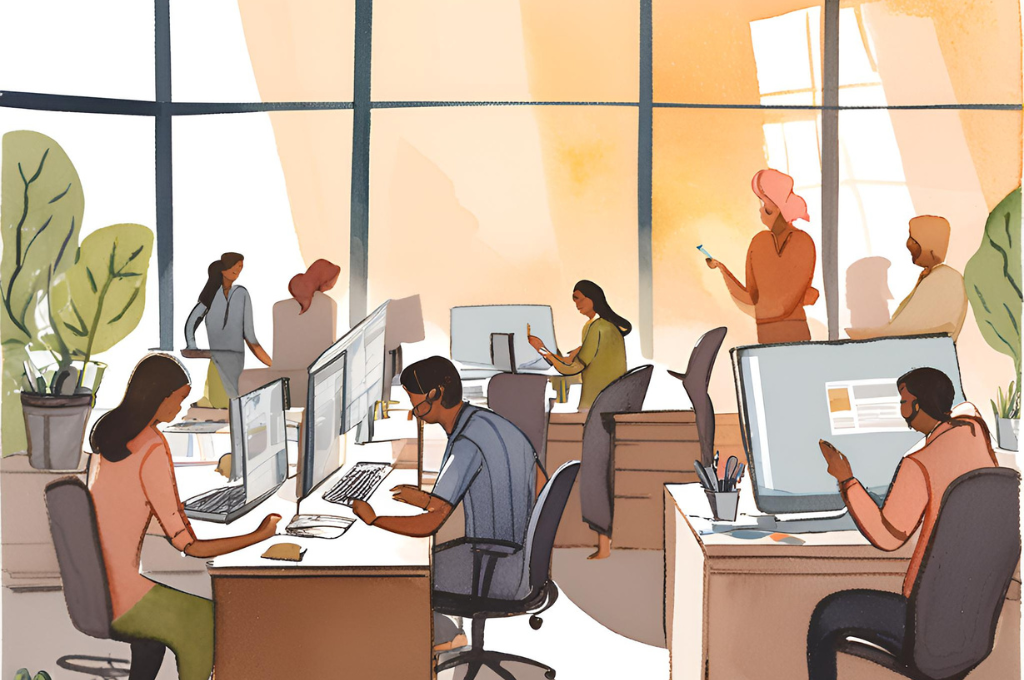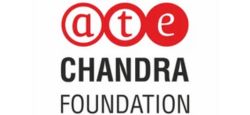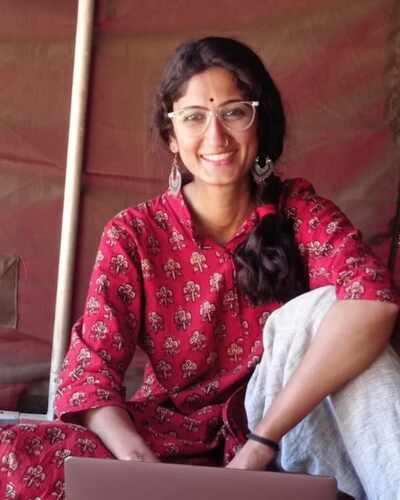Between 2017 and 2024, Makkala Jagriti (MJ)—a nonprofit based in Karnataka—grew from a team of 30 to 150 people. Their presence scaled from working in five districts to working in 13. And the number of children they engaged with increased from 10,000 to 30,000.
How?
According to Sunayana Chatrapathy, MJ’s CEO, a large part of this growth can be attributed to the nonprofit’s investment in people and culture.
MJ believes that investing in their team members and developing a culture where employees feel heard can strengthen organisational health, and therefore impact. This case study highlights their journey in building a people-centric organisation with a focus on democratic decision-making. It explores their reasons behind, and strategies for, promoting a value-centric organisational culture, the challenges they faced in doing so, and why they persisted.
Tracing MJ’s journey
According to Sunayana, MJ’s culture “has always been very people-centric, inclusive, and empowering. However, for the first few years, the practices for fostering a people-centric culture were unwritten and informal.”
With a small team, new initiatives were often spontaneous, driven by immediate needs or new opportunities. For instance, when MJ partnered with an organisation specialising in personal safety, they recognised the need for capacity building in this area and promptly organised training for the entire team. Similarly, if the leadership met with potential partners or collaborators, they were able to swiftly decide on capacity-building collaborations. And lastly, the entire team would meet much more frequently—at least once a month—for sharing, review, and reflection.
This changed in 2017, when the nonprofit began to grow rapidly.
The expansion was not just in terms of the number of people, but also in the number of programmes and districts covered, and the depth of these programmes. Ensuring everyone’s participation and voice in this period of growth required careful planning and deliberations. The logistics for team meetings became more complex, with greater reliance on everyone’s availability.
As such, the organisation’s leadership set out to formalise some of their practices. This involved creating an annual plan for people development and capacity building, standardising processes such as performance reviews and learning practices, and creating an extended leadership team. Here’s what this looked like in practice.
1. Articulating organisational culture
Articulating and practising organisational culture is extremely important as the organisation grows. This can be achieved by using communication tools—such as posters and presentations—as well as by engaging in dialogue and reflection. Articulating values involves emphasising them during the induction process, reiterating them during annual meetings, and encouraging programme leaders to consciously integrate them into their respective forums.
In events such as annual or mid-year team meetings, MJ creates experiential sessions where team members understand and internalise the organisation’s vision, mission, and values through creative expression via songs, poetry, theatre, and art, among others. Experience, reflect, think, and act—Sunayana highlights that sessions with team members follow this cycle for a better learning experience. And lastly, leaders role-model MJ’s values in their daily interactions with team members and other stakeholders.
2. Strengthening leadership
Makkala Jagriti’s leadership team plays a crucial role as custodians of its culture. Significant investment has been made in the team’s development through personal effectiveness trainings for managers and coordinators, with active involvement from board members.
Entrusting the leadership to uphold MJ’s people-centric culture is a distinctive approach. Joy Srinivasan, MJ’s founder, consciously stepped back from her executive position, entrusting the nonprofit to others while assuming a mentoring role. This demonstrated immense trust in the leadership, which has developed role models within the organisation at different levels.
3. Building for democratic decision-making
To promote democratic decision-making, Makkala Jagriti created an Extended Leadership Team (XLT), comprising representatives from all programmes and functions. Organisational policies, programme challenges, and best practices are discussed within this forum. This has led to collaborative decisions such as the implementation of a simplified leave policy, upgrading of the child protection policy, and adoption of cross-learning best practices from various programmes and functions.
Input from everyone—from the facilitators who work on the field to the coordinators and from the managers to the executive leadership—is included while making the organisational strategy at the annual team meeting. This process fosters a sense of ownership, buy-in, and motivation across the team, making it more likely for the strategy to be successfully implemented. Sunayana highlights, “MJ runs a programme in government schools that focuses on the holistic development of children through the SPICE model, which covers social, physical, intellectual, creative, and emotional and ethical development. Initially, the programme was designed to serve all children. However, facilitators strongly felt that the foundational literacy and numeracy (FLN) aspect of the programme should be targeted only at children who are below grade level. This idea was discussed and debated. Ultimately, the strategy was adjusted.”
4. Calendarising capacity-building events
As the nonprofit scaled up, MJ moved from building the capacity of their workforce sporadically to a well-planned annual calendar of capacity- building activities, such as annual and mid-year team trainings, exposure visits, well-being events, trainings for personal effectiveness, and annual team meetings. This shift is ensuring that all employees, regardless of their position or location, have access to continuous development opportunities. Additionally, there are ongoing efforts to assess training needs as per different roles in the organisation. Sunayana elaborates, “If something is not working, there is a need to build capacity in that area. We assess these needs regularly in different ways—through surveys, reviews, discussions, meetings, and so on.”
A recent initiative undertaken has been to map the technical skills and attitudinal aspects required for all job roles, which will lead to an even more effective capacity- building plan and calendar for the organisation. Additionally, MJ is building lLeadership and dDevelopment as a separate, dedicated function to focus on.
5. Focusing on strengths
The introduction of the strengths philosophy in 2021 has been an interesting milestone in the nonprofit’s people development journey. Leaders and mid-level team members took the Gallup Strengths Finder test and underwent a consistent learning and reflection process for more than a year. Sunayana says that this was a game changer: “We learned that, for incredible performance, it was much better not to fix people’s weaknesses, but to identify their strengths and build on them.” Focusing on strengths was pivotal for MJ in many ways. Firstly, it provided an opportunity for individuals to understand themselves better through the lens of their unique qualities, encouraging them to nurture these qualities and excel in their roles. Secondly, it facilitated a deeper understanding and acceptance of differences—whether in execution, strategic thinking, relationship building, or other areas. This insight enabled managers to collaborate more effectively by complementing one another’s strengths.

Challenges along the way
Unsurprisingly, Makkala Jagriti has also faced many challenges in maintaining a people-centric culture as they grow. Sunayana points out that while this kind of organisational culture has more benefits than negatives, it is sometimes a double-edged sword.
Rohit Shetti, deputy director of programmes at MJ, says, “Some practices that we had from the beginning are becoming more challenging as we grow. For instance, organising full team meetings has become increasingly difficult with our expansion to 150 people. Initially, we held these meetings monthly, then quarterly, then semi-annually, and now we organise them just once a year. While these meetings were valuable for team bonding and fostering a sense of belonging, the logistics and resources required have made it tough to maintain this frequency. To address this, we have shifted to more regular virtual connections.”
Other challenges that MJ faces include:
1. Consensus building
Sunayana and Rohit shared how achieving consensus can be a time-consuming process, and there may be disagreements that cannot always be resolved. Knowing when to seek consensus—such as while expanding a programme or changing policy—and when to take decisive action, especially in time-sensitive situations where consultation hasn’t led to clear conclusions, is crucial for maintaining momentum and moving forward effectively.
2. Ownership in collective processes
In situations or processes where there is an expectation for team members to volunteer and take ownership of tasks, there is sometimes a tendency for individuals to wait and see who will step up, especially events or projects requiring collective effort. Rohit mentions, “A recent example is the planning and execution of the annual team meeting—a large event with more than 100 participants, including employees travelling from other districts. Ideally, we hope for team members to proactively take on event responsibilities, but there’s often a hesitation as they wait to see who will step up. This reluctance is usually because these tasks fall outside regular programmatic duties, and there is a tendency to stay within comfort zones. However, after the initial nudging and internalising of the larger purpose of such events, team members will rise to the occasion.”
3. Employee retention
Rohit also mentioned how it can be a disconcerting experience when there has been significant investment in people and they leave the nonprofit for better opportunities. This situation prompts questions about whether the investments are aligned with the expected returns for the organisation. However, MJ believes that investing in people eventually makes a difference to the sector as a whole, and hence the organisation shall continue to stand by its culture of investment in people.
4. Donor pushback
Another significant challenge has been navigating donor pushback on funding investments for people development. Donors often prioritise field implementation and programmatic learning costs over non-programmatic learning costs and staff welfare, thus making it difficult to secure funding for internal capacity-building initiatives. Often, to build employee capacity and a organisational culture, the nonprofit has had to dip into their unrestricted funds, which Sunayana underlined, is itself a challenge to raise.
The result of MJ’s investment
Despite the challenges, MJ has made a strong case for the importance of these investments, emphasising the direct impact on their programmes’ effectiveness and sustainability. The result of their investment takes a few shapes, namely:
1. Scale
Being on the same page regarding MJ’s values contributed to all wheels of the nonprofit working together smoothly, which Sunayana pointed out, helped the organisation scale up as there was no ambiguity. “Everybody is speaking the same language [in terms of values], and this is giving us the confidence to reach more people. We can go to more geographies and replicate our programmes, without the fear of being questioned about whether we will be able to do it in the same way somewhere else.”
An example is the rapid expansion of MJ’s programme with child care institutions. What began as a two-member team working in two institutions in one district quickly grew into a 30-member team operating in 27 institutions across 10 districts. Trusting each other and ensuring that the team is well prepared to work with children gave MJ the conviction to scale. Sunayana adds, “Funders don’t just rely on proposals or documents—they focus on the people on the ground. That’s why confidence in our team is key. For instance, when we expanded to 10 districts, we had to present a clear capacity-building plan for new hires.” Additionally, an encouraging workspace has enhanced ambition and risk-taking—both of which are crucial for successful scaling.
2. Impact
Being people-centric also has an impact on the quality of the programmes themselves. Team members are more motivated to excel in their roles when they recognise that the organisation has invested in their development and trusts them. They no longer view their tasks as mere programme activities but instead connect deeply with the nonprofit’s mission and purpose. As MJ’s interventions with children and youth are also centred around providing safe, non-judgmental spaces, and openness and learning through reflection, it helps that MJ’s team members experience the same within the organisation.
3. Programme strength
Including voices from across the organisation has helped strengthen its programmes—both by adding innovations as well as evolving the overall approach and structure of the programme itself. One such example is reimagining their Community Transformation Programme. Previously, the work with children and youth from urban poor communities was being done more or less independent from each other. However, during a programme review exercise, the team realised that MJ possessed the capability, expertise, and experience to work with all age groups—from preschoolers to schoolgoing children to youth—and across different settings and communities. In view of this, MJ’s interventions in urban poor communities were restructured into an integrated Community Transformation Programme, with a team structure that looked at all stakeholders within the community together.
MJ’s advice to other nonprofits looking to invest in people and organisational culture
1. Empower people at all levels
“It is important to invest in employees and staff as people, and not just as resources for your organisation,” Sunayana asserts. The MJ board has been sensitive to people development and is actively involved in it, apart from guiding the organisation in terms of broader programme strategy and growth. The XLT is given the autonomy to make decisions on talent, finance, strategy, innovation, expansions, and collaborations, among other things.
This people-centric approach has resulted in many leaders who have grown from within the organisation. Sunayana mentions, “For instance, people who started as facilitators have progressed to roles such as coordinators, deputy managers, and managers. I myself began as a volunteer, then became a manager, a director, and now serve as the CEO.” This internal growth provides a strong foundation and core strength to the nonprofit, boosts retention and commitment, and amplifies overall impact.
2. View people and culture as a ‘core’ part of your work
Having clearly seen the impact that investing in people development can have, MJ’s journey is a testament to why more nonprofits should consider viewing it as a core function. The organisation’s growth and well-being is a direct function of people’s growth and well-being. This means including capacity building in the programme budgets, having annual plans for the same, and dedicating time and resources to it. MJ currently allocates 8–10 percent of its budget on people development and culture building (this has remained steadfast through the organisation’s growth).
MJ’s advice to donors
1. Be open-minded and trust the nonprofit
Donors should respect the organisation’s values and culture, fostering open dialogues on issues and perspectives, and avoiding the imposition of external ideas. This also means celebrating and recognising achievements together, sharing impact more regularly, and having conversations that include critical and constructive feedback. Sunayana elaborates, “For example, one of our core values is trust in our employees. However, a donor insisted that every employee share their live location at the start and end of each day. This went against our organisational culture, leading to frequent clashes, and we eventually ended the partnership within a year. We encourage donors to reconsider such restrictive guidelines.” Donors taking the time to understand a nonprofit’s work and outcomes, along with providing feedback, is a valuable learning opportunity for nonprofits, particularly in narrating their impact.
2. Support internal capacity building across levels
Donors should also invest in capacity-building initiatives that extend beyond programmatic needs. Allocation of more funds for people and organisation development should become an integral part of grants. Sunayana says, “For instance, some donors refuse to support staff training, assuming the team should already be fully trained. In these cases, we take them through the process of hiring, capacity building, and the long-term benefits of personal and professional growth for our staff. These discussions require curiosity, patience, and a willingness to understand the bigger picture. While some donors trust our judgement and provide support, others rigidly stick to policies that only fund work directly benefitting the children.”
Rather than adopting a blanket policy of only funding direct ‘beneficiary’ work, donors should recognise that investing in staff development can significantly enhance long-term and sustainable outcomes.
—
About Sunayana and Rohit
Sunayana Chatrapathy, CEO of Makkala Jagriti, has more than 14 years experience in IT, human resource development, and the social sector. She has grown from within the nonprofit to head MJ. Starting her foray into the development sector with the SBI Youth for India Fellowship, she has worked at the grassroots level in education, and led the scaling up of programmes at Makkala Jagriti.
Rohit Shetti has 24 years of experience spanning industrial and non-profit sectors. He started as a volunteer with different nonprofits before taking a full-time role in the development sector. He has worked across different themes in the sector. He currently leads the programmes at Makkala Jagriti.
—
Know more
- Learn more about how nonprofits can build organisational development from ground up.
- Learn more about microcultures at the workplace.
- Read more about mental health at the nonprofit workplace.
Do more
- Funders who are interested in supporting capacity building for nonprofits can read more about the GROW Fund, Rebuild India, and SVP Support.







